Luteinizing Hormone Receptor Is Expressed in Testicular Germ Cell Tumors: Possible Implications for Tumor Growth and Prognosis
Abstract
1. Introduction
2. Results
2.1. Expression of LHCGR Isoforms in Testicular Germ Cell Tumors
2.2. LHCGR Protein Detected in GCNIS and Seminoma
2.3. LHCGR Activation Regulates Proliferation of a Seminoma-Derived Cell Line In Vitro and In Vivo
2.4. Serum LHCGR Is Associated with Tumor Burden and Elevated LDH in Seminoma Patients
2.5. Evaluation of Serum Level of LHCGR during Monitoring of TGCT Patients with and without Relapse
3. Discussion
4. Materials and Methods
4.1. Human Tissue Samples
4.2. Cell Culture, qPCR, and Proliferation Assay
4.3. Western Blotting and Immunohistochemistry
4.4. Measurements of LHCGR in Serum
4.5. Establishment of Xenograft Mouse Models
4.6. Statistical Analysis
5. Conclusions
Supplementary Materials
Author Contributions
Funding
Acknowledgments
Conflicts of Interest
References
- Gurney, J.K.; Florio, A.A.; Znaor, A.; Ferlay, J.; Laversanne, M.; Sarfati, D.; Bray, F.; McGlynn, K.A. International Trends in the Incidence of Testicular Cancer: Lessons from 35 Years and 41 Countries. Eur. Urol. 2019, 76, 615–623. [Google Scholar] [CrossRef] [PubMed]
- Skakkebæk, N.E. Possible Carcinoma-in-Situ of the Testis. Lancet 1972, 300, 516–517. [Google Scholar] [CrossRef]
- Kraggerud, S.M.; Hoei-Hansen, C.E.; Alagaratnam, S.; Skotheim, R.I.; Abeler, V.M.; Meyts, E.R.D.; Lothe, R.A. Molecular characteristics of malignant ovarian germ cell tumors and comparison with testicular counterparts: Implications for pathogenesis. Endocr. Rev. 2013, 34, 339–376. [Google Scholar] [CrossRef] [PubMed]
- Rajpert-De Meyts, E.; McGlynn, K.A.; Okamoto, K.; Jewett, M.A.S.; Bokemeyer, C. Testicular germ cell tumours. Lancet 2016, 387, 1762–1774. [Google Scholar] [CrossRef]
- Bosl, G.J.; Lange, P.H.; Nochomovitz, L.E.; Goldmann, A.; Fraley, E.E.; Rosai, J.; Johnson, K.; Kennedy, B.J. Tumor markers in advanced nonseminomatous testicular cancer. Cancer 1981, 47, 572–576. [Google Scholar] [CrossRef]
- Milose, J.C.; Filson, C.P.; Weizer, A.Z.; Hafez, K.S.; Montgomery, J.S. Role of biochemical markers in testicular cancer: Diagnosis, staging, and surveillance. Open Access J. Urol. 2011, 4, 1–8. [Google Scholar] [CrossRef]
- Ahtiainen, P.; Rulli, S.; Pakarainen, T.; Zhang, F.P.; Poutanen, M.; Huhtaniemi, I. Phenotypic characterisation of mice with exaggerated and missing LH/hCG action. Mol. Cell. Endocrinol. 2007, 260–262, 255–263. [Google Scholar] [CrossRef]
- Huhtaniemi, I. Mutations along the pituitary-gonadal axis affecting sexual maturation: Novel information from transgenic and knockout mice. Mol. Cell. Endocrinol. 2006, 254–255, 84–90. [Google Scholar] [CrossRef]
- Atger, M.; Misrahi, M.; Sar, S.; Le Flem, L.; Dessen, P.; Milgrom, E. Structure of the human luteinizing hormone-choriogonadotropin receptor gene: Unusual promoter and 5′ non-coding regions. Mol. Cell. Endocrinol. 1995, 111, 113–123. [Google Scholar] [CrossRef]
- Chambers, A.E.; Nayini, K.P.; Mills, W.E.; Lockwood, G.M.; Banerjee, S. Circulating LH/hCG receptor (LHCGR) may identify pre-treatment IVF patients at risk of OHSS and poor implantation. Reprod. Biol. Endocrinol. 2011, 9, 161. [Google Scholar] [CrossRef]
- Mortensen, L.J.; Lorenzen, M.; Jørgensen, N.; Andersson, A.M.; Juul, A.; Blomberg Jensen, M. Soluble Luteinizing Hormone Receptor is associated with pubertal development and gonadal function in boys and men. J. Clin. Endocrinol. Metab. 2020, submitted. [Google Scholar]
- Meduri, G.; Charnaux, N.; Loosfelt, H.; Jolivet, A.; Spyratos, F.; Brailly, S.; Milgrom, E. Luteinizing hormone/human chorionic gonadotropin receptors in breast cancer. Cancer Res. 1997, 57, 857–864. [Google Scholar] [PubMed]
- Minegishi, T. Expression of luteinizing hormone/human chorionic gonadotrophin (LH/HCG) receptor mRNA in the human ovary. Mol. Hum. Reprod. 1997, 3, 101–107. [Google Scholar] [CrossRef] [PubMed]
- Costa, M.H.S.; Latronico, A.C.; Martin, R.M.; Barbosa, A.S.; Almeida, M.Q.; Lotfi, C.F.P.; Lima Valassi, H.P.; Nishi, M.Y.; Lucon, A.M.; Siqueira, S.A.; et al. Expression profiles of the Glucose-dependent insulinotropic peptide receptor and LHCGR in sporadic adrenocortical tumors. J. Endocrinol. 2009, 200, 167–175. [Google Scholar] [CrossRef] [PubMed]
- Friess, H.; Markus, B.; Kiesel, L.; Kriiger, M.; Beger, H.G. LH-RH Receptors in the Human Pancreas. Int. J. Pancreatol. 1991, 10, 151–159. [Google Scholar] [PubMed]
- Tao, Y.-X.; Bao, S.; Ackermann, D.M.; Lei, Z.M.; Rao, C.V. Expression of Luteinizing Hormone/Human Chorionic Gonadotropin Receptor Gene in Benign Prostatic Hyperplasia and in Prostate Carcinoma in Humans. Biol. Reprod. 2005, 56, 67–72. [Google Scholar] [CrossRef]
- Mortensen, L.J.; Blomberg Jensen, M.; Christiansen, P.; Rønholt, A.M.; Jørgensen, A.; Frederiksen, H.; Nielsen, J.E.; Loya, A.C.; Grønkær Toft, B.; Skakkebæk, N.E.; et al. Germ cell neoplasia in situ and preserved fertility despite suppressed gonadotropins in a patient with testotoxicosis. J. Clin. Endocrinol. Metab. 2017, 102, 4411–4416. [Google Scholar] [CrossRef]
- Thu VuHai-LuuThi, M.; Misrahi, M.; Houllier, A.; Jolivet, A.; Milgrom, E. Variant Forms of the Pig Lutropin/Choriogonadotropin Receptor. Biochemistry 1992, 31, 8377–8383. [Google Scholar] [CrossRef]
- Banerjee, S.; Smallwood, A.; Chambers, A.E.; Papageorghiou, A.; Loosfelt, H.; Spencer, K.; Campbell, S.; Nicolaides, K. A link between high serum levels of human chorionic gonadotrophin and chorionic expression of its mature functional receptor (LHCGR) in Down’s syndrome pregnancies. Reprod. Biol. Endocrinol. 2005, 3, 25. [Google Scholar] [CrossRef][Green Version]
- Marlicz, W.; Poniewierska-Baran, A.; Rzeszotek, S.; Bartoszewski, R.; Skonieczna-Żydecka, K.; Starzyńska, T.; Ratajczak, M.Z. A novel potential role of pituitary gonadotropins in the pathogenesis of human colorectal cancer. PLoS ONE 2018, 13, e0189337. [Google Scholar] [CrossRef]
- Zhao, R.; Zhang, T.; Xi, W.; Sun, X.; Zhou, L.; Guo, Y.; Zhao, C.; Bao, Y. Human chorionic gonadotropin promotes cell proliferation through the activation of c-Met in gastric cancer cells. Oncol. Lett. 2018, 16, 4271–4278. [Google Scholar] [CrossRef] [PubMed]
- Huang, Y.; Zhou, Y.; Xia, L.; Tang, J.; Wen, H.; Zhang, M. Luteinizing hormone compromises the in vivo anti-tumor effect of cisplatin on human epithelial ovarian cancer cells. Oncol. Lett. 2018, 15, 3141–3146. [Google Scholar] [CrossRef] [PubMed]
- Riccetti, L.; Yvinec, R.; Klett, D.; Gallay, N.; Combarnous, Y.; Reiter, E.; Simoni, M.; Casarini, L.; Ayoub, M.A. Human Luteinizing Hormone and Chorionic Gonadotropin Display Biased Agonism at the LH and LH/CG Receptors. Sci. Rep. 2017, 7, 940. [Google Scholar] [CrossRef] [PubMed]
- Casarini, L.; Lispi, M.; Longobardi, S.; Milosa, F.; la Marca, A.; Tagliasacchi, D.; Pignatti, E.; Simoni, M. LH and hCG Action on the Same Receptor Results in Quantitatively and Qualitatively Different Intracellular Signalling. PLoS ONE 2012, 7, e0046682. [Google Scholar] [CrossRef] [PubMed]
- Gillott, D.J.; Iles, R.K.; Chard, T. The effects of beta-human chorionic gonadotrophin on the in vitro growth of bladder cancer cell lines. Br. J. Cancer 1996, 73, 323–326. [Google Scholar] [CrossRef] [PubMed]
- Rivera, R.T.; Pasion, S.G.; Wong, D.T.W.; Fai, Y.; Biswas, D.K. Loss of tumorigenic potential by human lung tumor cells in the presence of antisense RNA specific to the ectopically synthesized alpha subunit of human chorionic gonadotropin. J. Cell Biol. 1989, 108, 2423–2434. [Google Scholar] [CrossRef] [PubMed]
- Khare, P.; Bose, A.; Singh, P.; Singh, S.; Javed, S.; Jain, S.K.; Singh, O.; Pal, R. Gonadotropin and tumorigenesis: Direct and indirect effects on inflammatory and immunosuppressive mediators and invasion. Mol. Carcinog. 2017, 56, 359–370. [Google Scholar] [CrossRef]
- Sahoo, S.; Singh, P.; Kalha, B.; Singh, O.; Pal, R. Gonadotropin-mediated chemoresistance: Delineation of molecular pathways and targets. BMC Cancer 2015, 15, 931. [Google Scholar] [CrossRef]
- Melmed, S.; Braunstein, G. Human Chorionic Gonadotropin Stimulates Proliferation of Nb 2 Rat Lymphoma Cells. J. Clin. Endocrinol. Metab. 1983, 56, 1068–1107. [Google Scholar] [CrossRef]
- Kumar, S.; Talwar, G.; Biswas, D. Necrosis and Inhibition of Growth of Human Lung Tumor by Anti-α-Human Chorionic Gonadotropin Antibody. J. Natl. Cancer Inst. 1992, 84, 42–47. [Google Scholar] [CrossRef]
- Martin, M.M.; Wu, S.M.; Martin, A.L.A.; Rennert, O.M.; Chan, W.Y. Testicular seminoma in a patient with a constitutively activating mutation of the luteinizing hormone/chorionic gonadotropin receptor. Eur. J. Endocrinol. 1998, 139, 101–106. [Google Scholar] [CrossRef] [PubMed]
- Dunkel, L.; Raivio, T.; Laine, J.; Holmberg, C. Circulating luteinizing hormone receptor inhibitor(s) in boys with chronic renal failure. Kidney Int. 1997, 51, 777–784. [Google Scholar] [CrossRef] [PubMed][Green Version]
- Kolena, J.; Šeböková, E. Porcine follicular fluid containing water-soluble LH/hCG receptor. Arch. Physiol. Biochem. 1986, 94, 261–270. [Google Scholar] [CrossRef] [PubMed]
- West, A.P.; Cooke, B.A. Regulation of the truncation of luteinizing hormone receptors at the plasma membrane is different in rat and mouse leydig cells. Endocrinology 1991, 128, 363–370. [Google Scholar] [CrossRef] [PubMed]
- Remy, J.J.; Nespoulous, C.; Grosclaude, J.; Grébert, D.; Couture, L.; Pajot, E.; Salesse, R. Purification and structural analysis of a soluble human chorionogonadotropin hormone-receptor complex. J. Biol. Chem. 2001, 276, 1681–1687. [Google Scholar] [CrossRef]
- Gao, H.J.; Chen, Y.J.; Zuo, D.; Xiao, M.M.; Li, Y.; Guo, H.; Zhang, N.; Chen, R.B. Quantitative proteomic analysis for high-throughput screening of differential glycoproteins in hepatocellular carcinoma serum. Cancer Biol. Med. 2015, 12, 246–254. [Google Scholar] [CrossRef]
- Seidel, C.A.; Daugaard, G.; Nestler, T.; Tryakin, A.; Fankhauser, C.D.; Hermanns, T.; Aparicio, J.; Heinzelbecker, J.; Paffenholz, P.; Heidenreich, A.; et al. Prognostic impact of LDH and HCG levels in marker-positive seminomas. J. Clin. Oncol. 2020, 38, 392. [Google Scholar] [CrossRef]
- Talerman, A.; Haije, W.G.; Baggerman, L. Serum alphafetoprotein (AFP) in patients with germ cell tumors of the gonads and extragonadal sites: Correlation between endodermal sinus (yolk sac) tumor and raised serum AFP. Cancer 1980, 46, 380–385. [Google Scholar] [CrossRef]
- Andrews, P.W.; Damjanov, I.; Simon, D.; Banting, G.S.; Carlin, C.; Dracopoli, N.C.; Føgh, J. Pluripotent embryonal carcinoma clones derived from the human teratocarcinoma cell line Tera-2. Differentiation in vivo and in vitro. Lab. Investig. 1984, 50, 147–162. [Google Scholar]
- Mizuno, Y.; Gotoh, A.; Kamidono, S.; Kitazawa, S. Establishment and characterization of a new human testicular germ cell tumor cell line (Tcam-2). Jpn. J. Urol. 1993, 84, 1211–1218. [Google Scholar] [CrossRef]
- Blomberg Jensen, M.; Andersen, C.B.; Nielsen, J.E.; Bagi, P.; Jørgensen, A.; Juul, A.; Leffers, H. Expression of the vitamin D receptor, 25-hydroxylases, 1α-hydroxylase and 24-hydroxylase in the human kidney and renal clear cell cancer. J. Steroid Biochem. Mol. Biol. 2010, 121, 376–382. [Google Scholar] [CrossRef] [PubMed]
- Mitchell, R.T.; Saunders, P.T.K.; Childs, A.J.; Cassidy-Kojima, C.; Anderson, R.A.; Wallace, W.H.B.; Kelnar, C.J.H.; Sharpe, R.M. Xenografting of human fetal testis tissue: A new approach to study fetal testis development and germ cell differentiation. Hum. Reprod. 2010, 25, 2405–2414. [Google Scholar] [CrossRef] [PubMed]
- Chambers, A.E.; Griffin, C.; Naif, S.A.; Mills, I.; Mills, W.E.; Syngelaki, A.; Nicolaides, K.H.; Banerjee, S. Quantitative ELISAs for serum soluble LHCGR and hCG-LHCGR complex: Potential diagnostics in first trimester pregnancy screening for stillbirth, Down’s syndrome, preterm delivery and preeclampsia. Reprod. Biol. Endocrinol. 2012, 10, 113. [Google Scholar] [CrossRef] [PubMed]
- Harpelunde Poulsen, K.; Nielsen, J.E.; Grønkær Toft, B.; Joensen, U.N.; Rasmussen, L.J.; Blomberg Jensen, M.; Mitchell, R.T.; Juul, A.; Rajpert-De Meyts, E.; Jørgensen, A. Influence of Nodal signalling on pluripotency factor expression, tumour cell proliferation and cisplatin-sensitivity in testicular germ cell tumours. BMC Cancer 2020, 20, 349. [Google Scholar] [CrossRef] [PubMed]
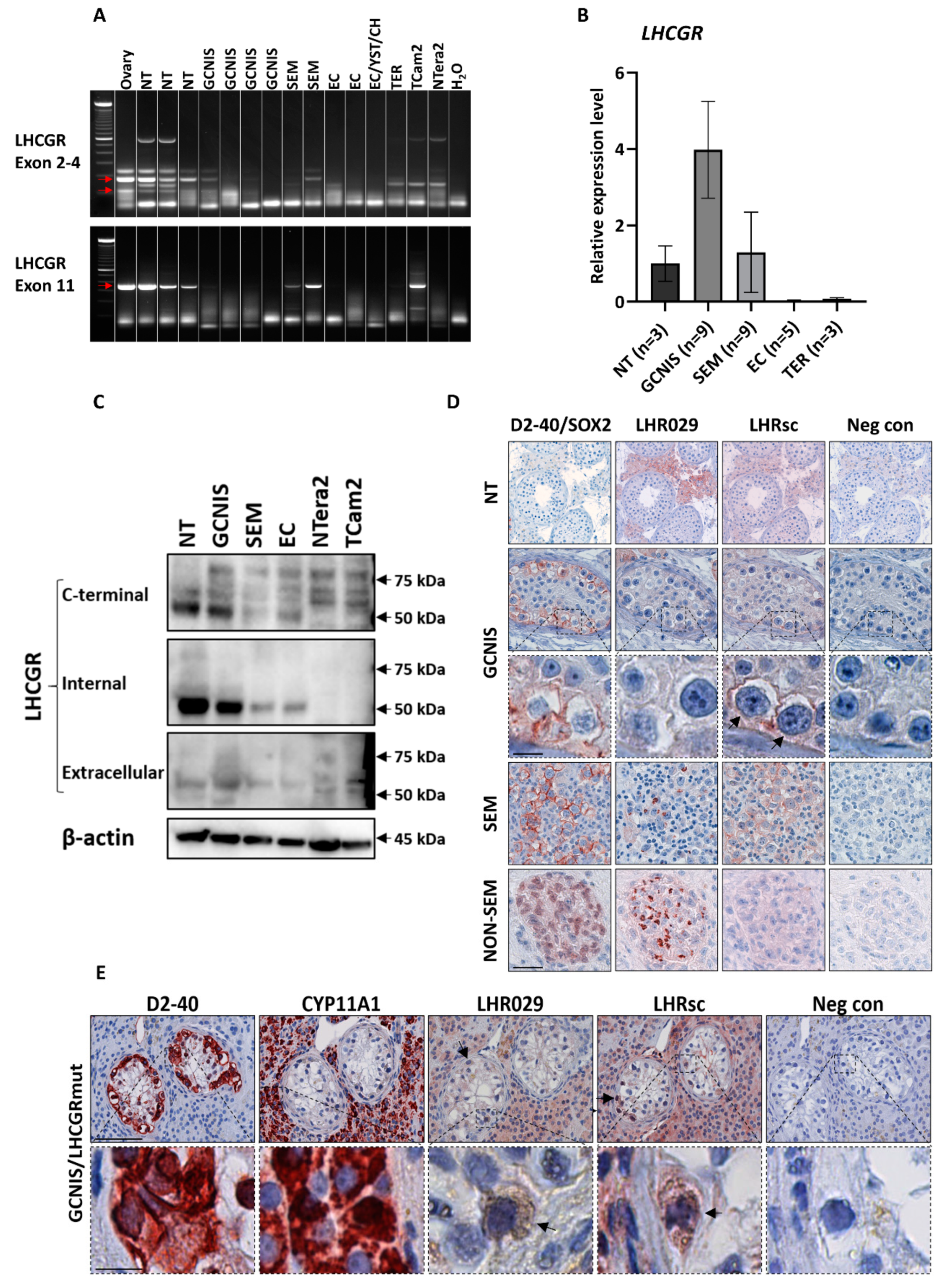
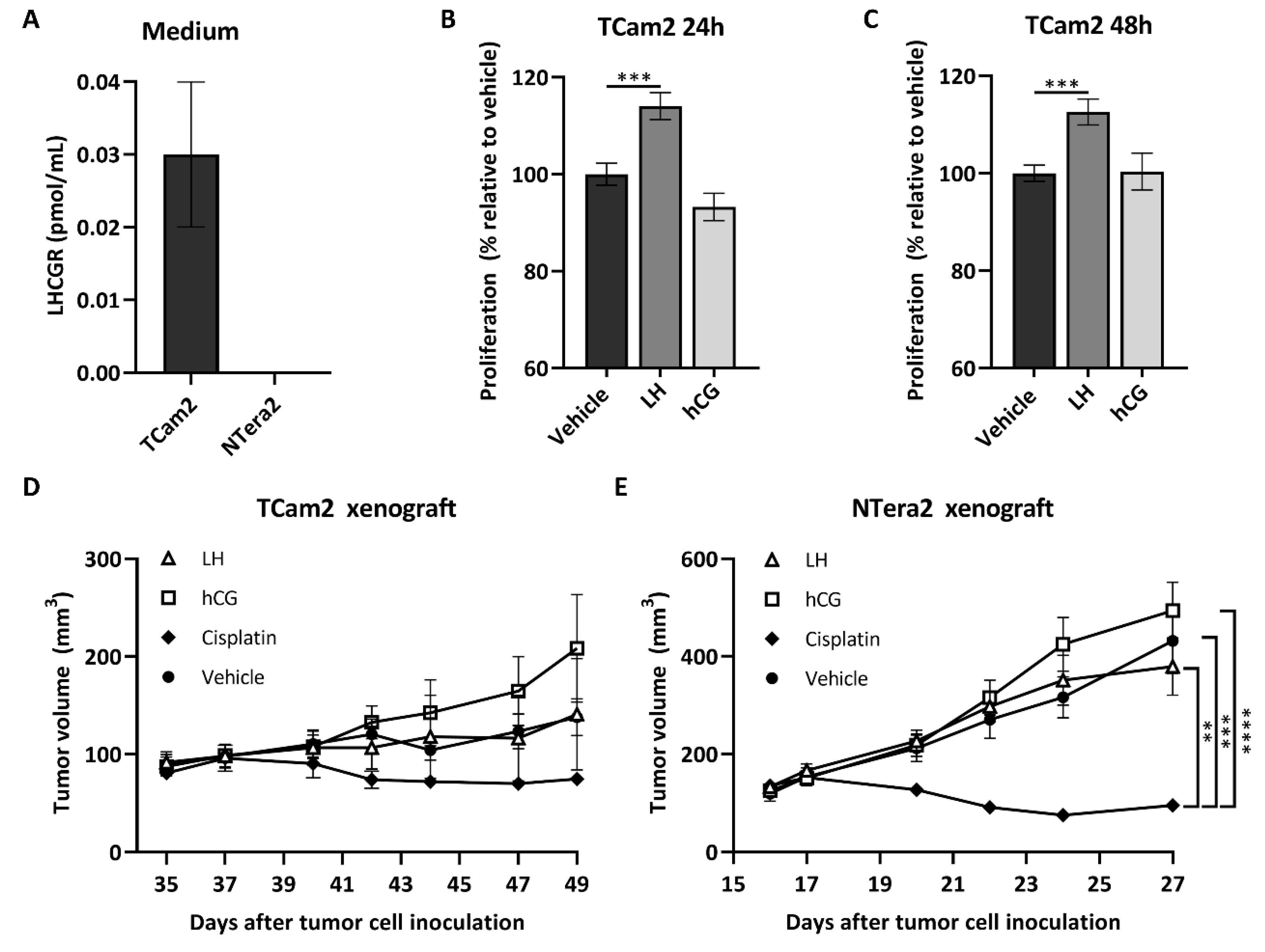
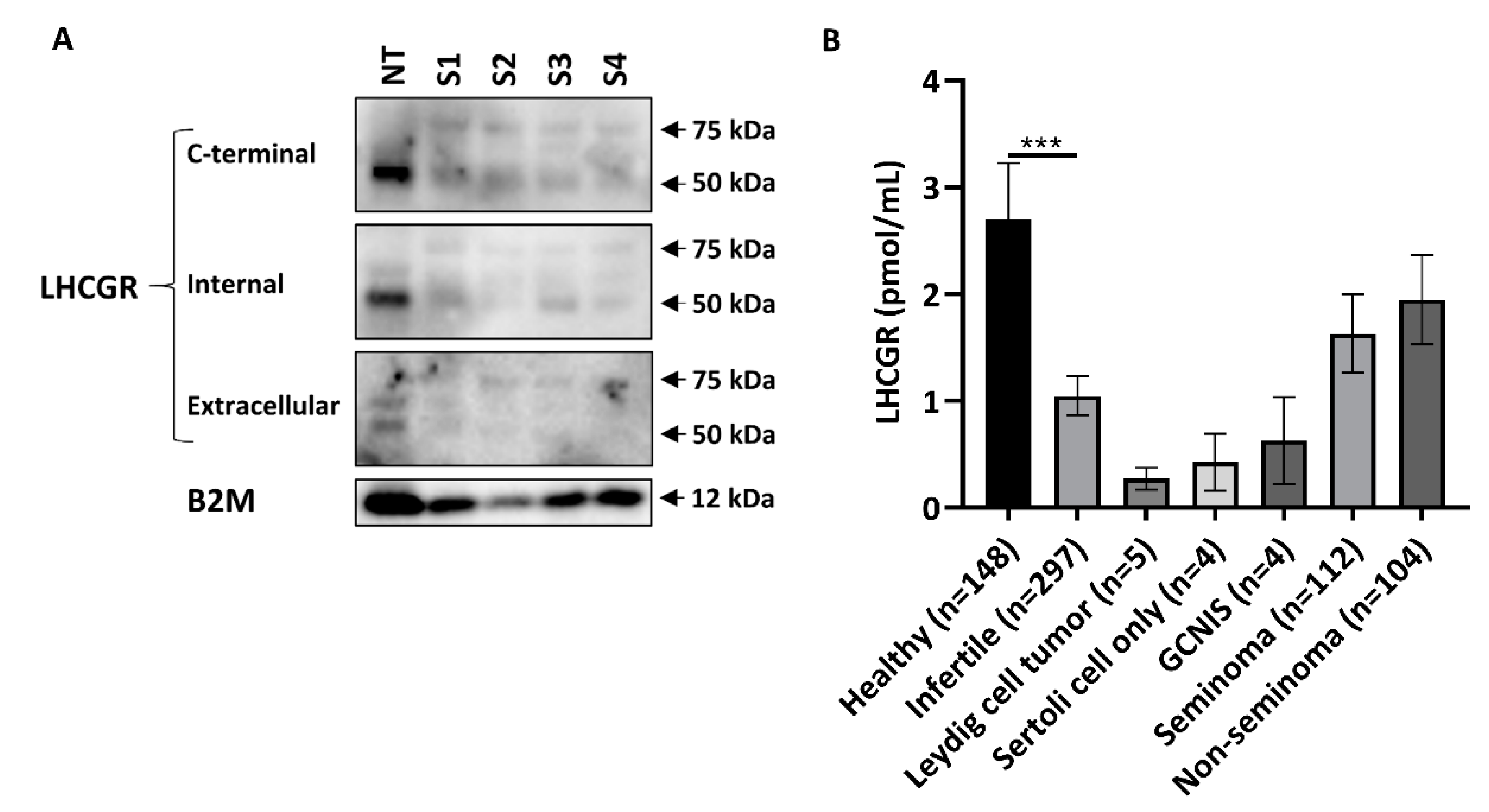
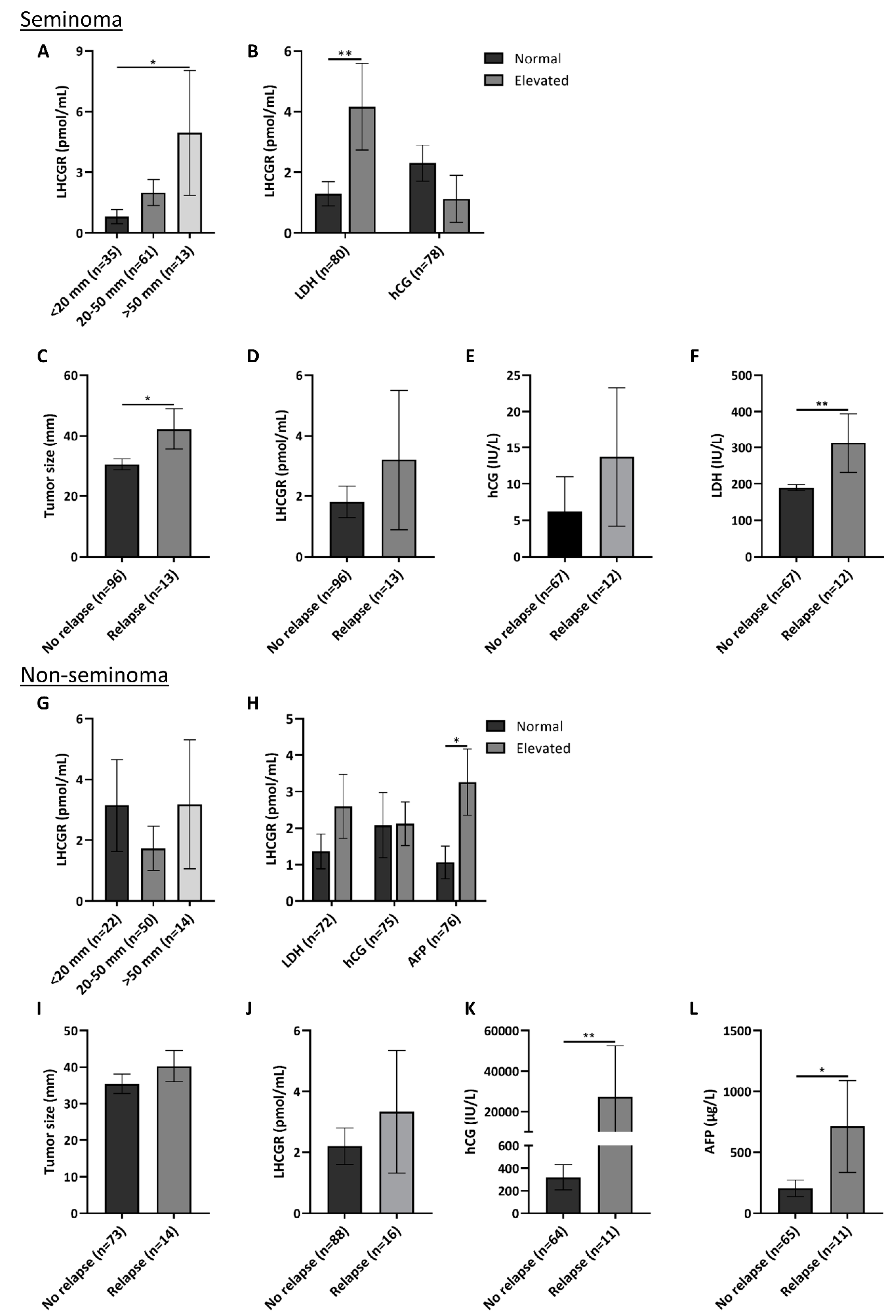
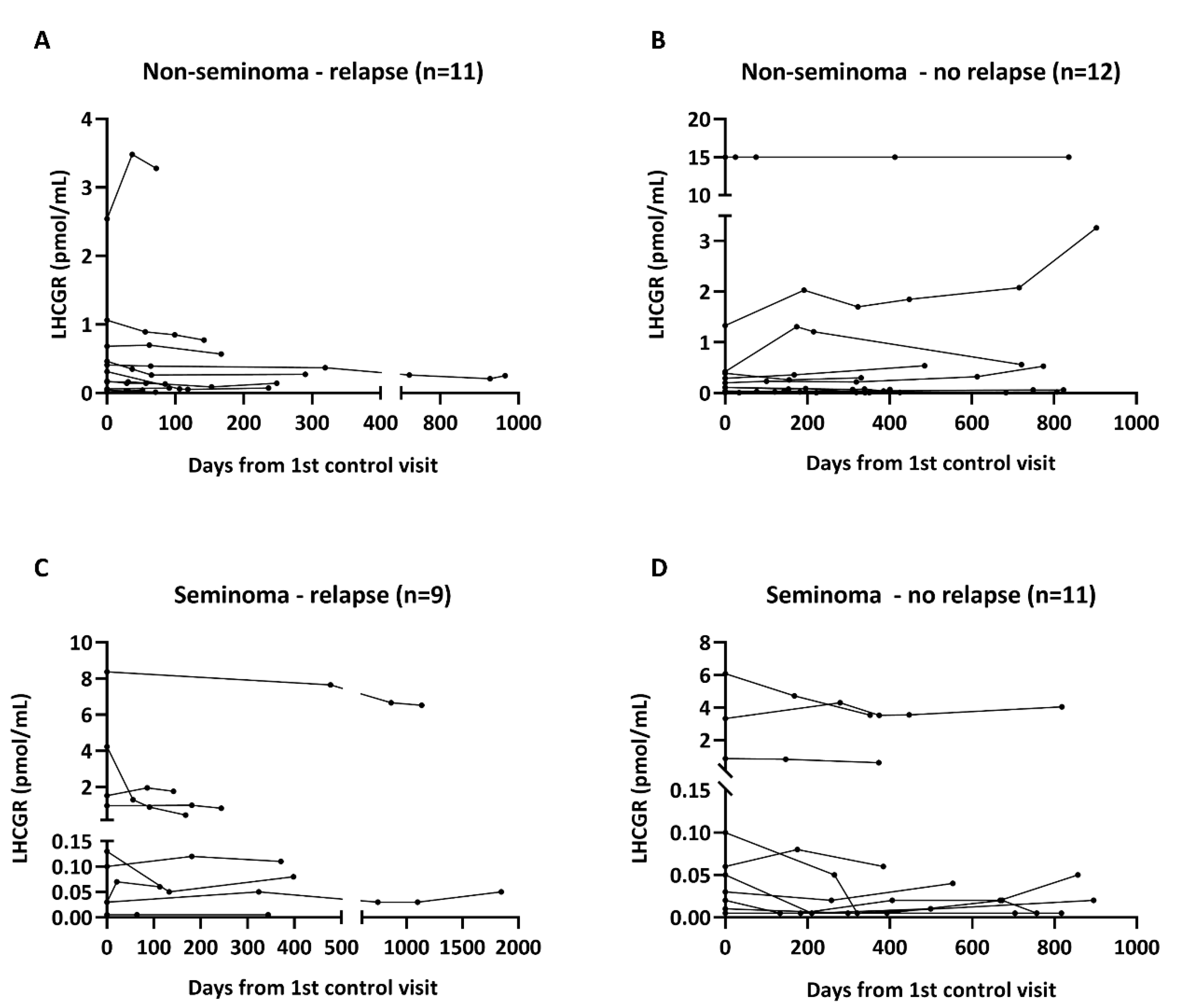
| RT-PCR | qPCR | IHC | WB | |
|---|---|---|---|---|
| GCNIS | −/+ | ++ | −/+ | ++ |
| Seminoma | +/++ | ++ | +/++ | + |
| Embryonal carcinoma | − | − | −/+ | + |
| NTera2 | − | NA | NA | + |
| TCam2 | + | NA | + | + |
© 2020 by the authors. Licensee MDPI, Basel, Switzerland. This article is an open access article distributed under the terms and conditions of the Creative Commons Attribution (CC BY) license (http://creativecommons.org/licenses/by/4.0/).
Share and Cite
Lorenzen, M.; Nielsen, J.E.; Andreassen, C.H.; Juul, A.; Toft, B.G.; Rajpert-De Meyts, E.; Daugaard, G.; Blomberg Jensen, M. Luteinizing Hormone Receptor Is Expressed in Testicular Germ Cell Tumors: Possible Implications for Tumor Growth and Prognosis. Cancers 2020, 12, 1358. https://doi.org/10.3390/cancers12061358
Lorenzen M, Nielsen JE, Andreassen CH, Juul A, Toft BG, Rajpert-De Meyts E, Daugaard G, Blomberg Jensen M. Luteinizing Hormone Receptor Is Expressed in Testicular Germ Cell Tumors: Possible Implications for Tumor Growth and Prognosis. Cancers. 2020; 12(6):1358. https://doi.org/10.3390/cancers12061358
Chicago/Turabian StyleLorenzen, Mette, John Erik Nielsen, Christine Hjorth Andreassen, Anders Juul, Birgitte Grønkær Toft, Ewa Rajpert-De Meyts, Gedske Daugaard, and Martin Blomberg Jensen. 2020. "Luteinizing Hormone Receptor Is Expressed in Testicular Germ Cell Tumors: Possible Implications for Tumor Growth and Prognosis" Cancers 12, no. 6: 1358. https://doi.org/10.3390/cancers12061358
APA StyleLorenzen, M., Nielsen, J. E., Andreassen, C. H., Juul, A., Toft, B. G., Rajpert-De Meyts, E., Daugaard, G., & Blomberg Jensen, M. (2020). Luteinizing Hormone Receptor Is Expressed in Testicular Germ Cell Tumors: Possible Implications for Tumor Growth and Prognosis. Cancers, 12(6), 1358. https://doi.org/10.3390/cancers12061358





